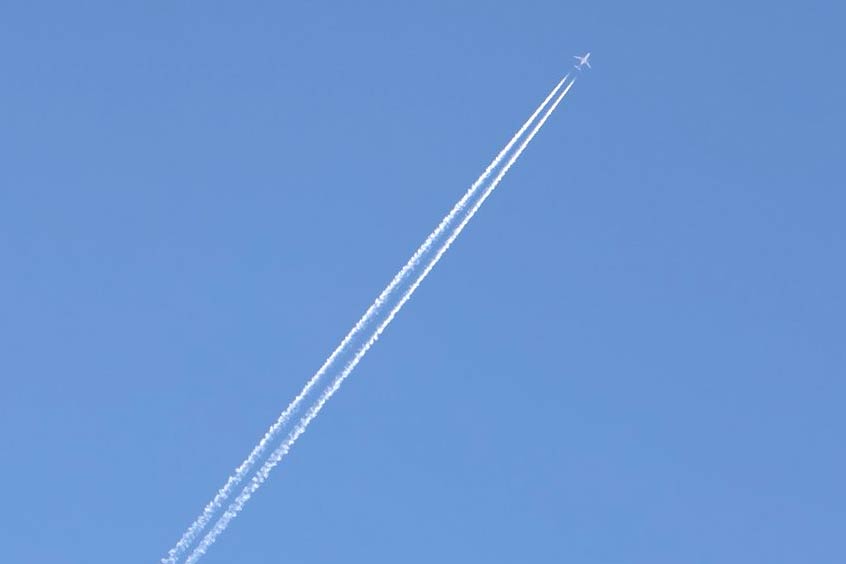Why visit ACE ’25?

In one of the largest international studies of its kind, 4Air has found that small altitude adjustments on business aviation flights could have a substantial impact on reducing their contrail impact on the environment, without CO2 trade offs.
Contrails, or condensation trails, are a product of aircraft engine emissions interacting with the right combination of temperature and humidity in the upper atmosphere.
Depending on the location and time of day, long-lasting or 'persistent' contrails can have an outsized warming impact, trapping and absorbing heat that otherwise would radiate back into space. Studies have estimated the overall net impact from contrails and non-CO2 emissions to be about twice that of CO2 alone, contributing to two-thirds of aviation's total warming impact.
The study, the largest flight-by-flight contrail footprint in business aviation, encompassed over 16,000 flights and over 27,000 flight hours and identified specific opportunities to mitigate contrails to reduce the impact from non-CO2 emissions.
According to the analysis, adjustments on just 50 flights out of 16,888 would have reduced the non-CO2 impact from this sample by more than 50 per cent overnight.
In conjunction, 4Air has also completed six months of a contrail avoidance pilot programme, launched in collaboration with Flexjet in Europe. The programme incorporated contrail forecasts into the dispatch process to optimise flight paths and minimise the time spent in contrail forming regions.
Where possible, flight paths were adjusted to modify cruising altitudes above these regions, and notes were shared with pilots to calibrate climbs or descents to minimise time spent in the contrail regions.
Kennedy Ricci, 4Air president, says: "The results of this study demonstrate both the challenges and opportunities with reducing aviation's footprint from contrails. Effectively reducing our contrail warming impact requires considering contrails on every flight, but successfully avoiding contrails on just a handful of flights would have a major impact, potentially without CO2 trade-offs."
Normally these contrail regions are thin, extending just 2,000 to 4,000 feet, but exist at the upper end of a commercial aircraft's service ceiling.
These business aviation aircraft, which have higher service ceilings, were found to have the unique opportunity to fly higher than the contrail formation region, reducing both CO2 emissions and their contrail impact instead of needing a trade off between the two. Flying higher does come with a slightly higher impact from NOx, but more research is needed to better understand the NOx emissions lifecycle as well as its comparison to CO2.
The analysis also found that contrails were at their lowest levels during the months of July and August, when demand to travel is usually at its peak.
The study utilised one of the leading weather-based contrail prediction models available today. Key results include:
- Of the over 16,000 flights, if just 0.3 per cent, or 50 flights, had been able to minimise their contrails, it would have reduced the overall contrail impact up to 51 per cent; minimising contrails from 0.73 per cent or 123 flights would have reduced it up to 75 per cent.
- Of the 23 flights with the highest contrail impact, accounting for around 35 per cent of the total contrail impact, 65 per cent of the flights could have avoided or minimised their impact by flying higher, resulting in reductions of the CO2 and contrail impact.
- About 18 per cent of flights created a contrail, and 69 per cent of those contrails had warming impacts.
- 31 per cent of contrails were estimated to have cooling effects, but they only offset the total contrail warming impact by about 13 per cent.
- The average contrail was estimated to persist for around 2.5 hours with the more impactful warming coming from contrails that persisted around 6.5 hours.
The lessons learned from the report lay the groundwork for 4Air's contrail reporting service, which helps operators better understand their specific non-CO2 impacts ahead of new regulation.
Starting in 2025, the European Union Emissions Trading Scheme (EU ETS) will include non-CO2 under operators' monitoring and reporting obligations. 4Air's service is currently available upon request to select partners.